Andrea Pflaumer's Blog, page 13
May 2, 2015
Style Type #3: Exuberant-Lively
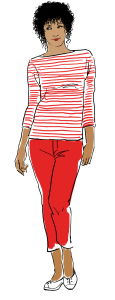
Illustration by Sue Tait Porcaro
Are you bored easily? Would it feel like death to wear the same thing every day? Is your shoe and accessory closet as big a deal for you as your basic wardrobe? Well then, you might just have a pretty measurable amount of the Exuberant – Lively style.
From my perspective, I think this is one of the more misunderstood and misinterpreted of the seven archetypes described in my book, Shopping for the Real You. That’s because frequently people confuse Exuberant-Lively with the Youthful–Playful style archetype.
Here’s the difference: Youthful types have a wide eyed innocence about them. Exuberant–Lively types will never be accused of being innocent. They have a bit of mischief about them. It’s the difference between being “sweet” and being a little “edgy.” Physically, they are often highly kinetic. They’d rather skip than walk, fidget than stand still, dance than watch a play. In fact, they’d rather be in the play –dancing – than be watching it!
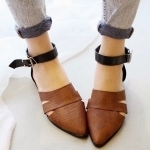
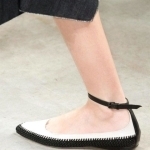
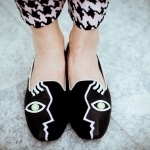 Since I referenced their shoe addiction, let’s take a look at a few pairs that define what it means to have a high-spirited style. You’ll often see “points” (or pointed toes) repeated dots (perforations in the leather) or over-stitching. They almost tell a “story” of some kind, as if they had their own voice: “I’m going somewhere,” “do you get the joke?” “Look at me!” And still, even with the more extreme examples, the scale and the pattern of the shapes is not overwhelming.
Since I referenced their shoe addiction, let’s take a look at a few pairs that define what it means to have a high-spirited style. You’ll often see “points” (or pointed toes) repeated dots (perforations in the leather) or over-stitching. They almost tell a “story” of some kind, as if they had their own voice: “I’m going somewhere,” “do you get the joke?” “Look at me!” And still, even with the more extreme examples, the scale and the pattern of the shapes is not overwhelming.
These types love to play dress-up, but there’s a lot of thought that goes into that haphazard-looking cleverness. One of the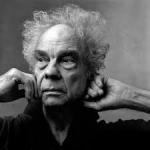 challenges with this style is in making sure that their outfit stays on this side of “costume.” Although, you certainly will find a lot of performers, particularly dancers and comics, who fall into this category.
challenges with this style is in making sure that their outfit stays on this side of “costume.” Although, you certainly will find a lot of performers, particularly dancers and comics, who fall into this category. 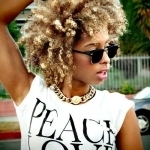
And although this blog is primarily for women, I have to show you a photo of one of my all-time favorite male dancers because he was the epitome of this type: Merce Cunningham. (The hair is often a giveaway – as it is in our darling girl here on the left.) First of all, I loved his name, which I always associated with “Winged Mercury.” There’s a quality of movement in these types, even when they are standing still.
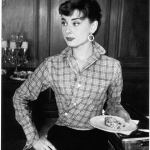 Now with all style archetypes, but particularly this one, you have to consider the overall impression. Let’s look at the ever-adorable Audrey Hepburn. Yes, Audrey had some Romantic and Classical, but the thing that was compelling about her was her impishness. There was always something brewing in those eyes. And regardless of her attire, whether it was cigarette pants and ballet flats or a ball gown, you expected that at any moment she would be up for some fun. And we got caught up in that fun.
Now with all style archetypes, but particularly this one, you have to consider the overall impression. Let’s look at the ever-adorable Audrey Hepburn. Yes, Audrey had some Romantic and Classical, but the thing that was compelling about her was her impishness. There was always something brewing in those eyes. And regardless of her attire, whether it was cigarette pants and ballet flats or a ball gown, you expected that at any moment she would be up for some fun. And we got caught up in that fun.
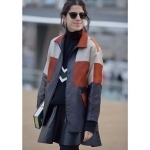
Another element of this style is that these women can get away with wearing things that are slightly oversized. But here’s the deal: there’s a big difference between wearing something that is one size too large, and wearing something that is intentionally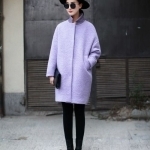 cut larger, like sporty jacket (on the left) or this gorgeous lilac coat. Yes, there is a lot of the clean, Classic clean line in both these images but they each still have something of a “wink, wink, nudge, nudge.” to them, with the flirty skirt and the hat and large, round sunglasses.
cut larger, like sporty jacket (on the left) or this gorgeous lilac coat. Yes, there is a lot of the clean, Classic clean line in both these images but they each still have something of a “wink, wink, nudge, nudge.” to them, with the flirty skirt and the hat and large, round sunglasses.
Then there are the hats! If ever there were a style that could rock a hat, it’s this one. None of these are really necessary, but they’re all just so much fun and they each bring a kind of “coda” to the outfits.

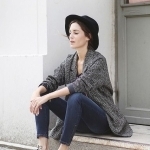
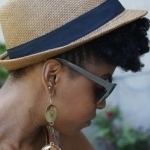

And, of course, the Exuberant-Lively style type is certainly not limited to any age. It’s all in the eyes, the expression, the motion.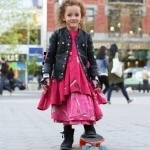
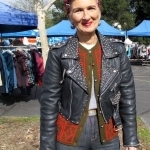

Motion, humor, taking life a little less seriously – this is what the Exuberant-Lively style type is all about.
So – how much of this style type do you have? Take the quiz in my book, Shopping for the Real You (available here and on Amazon) and find out!
The post Style Type #3: Exuberant-Lively appeared first on Shopping for the Real You.
March 25, 2015
Style type #2: How Natural–Relaxed Are You?
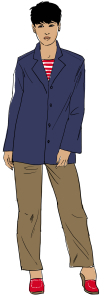
Illustration by Sue Tait Porcaro
Do you hate anything binding such as tight turtlenecks, ankle straps or constricting belts? Would you rather be in sneakers than stilettos? Does your “uniform” consist of loose sweaters and comfortable pants? If you say “yes” to more than one of these I’m guessing you have a good deal of the Natural – Relaxed style type.
In the Personal Style Counselors (PSC) system, Natural is the second most “yang” of the seven style archetypes. But it couldn’t be farther from the first one, Dramatic-Theatrical. In fact, almost everything about the Natural-Relaxed style is just about the opposite of how we would describe the Dramatic-Theatrical. Whereas Dramatic is all about intensity, Natural is all about being laid back. Where Dramatic controls the action (either directly or indirectly) Natural lets the river flow.
My own opinion is that as we age, most of us inch a little bit toward Natural. Maybe that’s because it’s the path of least resistance, as gravity does its thing. But don’t get the idea that Naturals are lazy. Most Natural-Relaxed types are pretty hard workers – or players. They tend to love the outdoors and sports in general. You’ll often find them playing tennis, working in their flower or vegetable gardens, or baking up a few dozen cookies for neighbors.
Fortunately, the design world has found a large demographic in this style – or it appeals to a broad range of women, across many styles. Natural-Relaxed types embrace natural fibers and easy draping, and those factors are a big 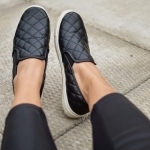 draw for many of us. So let’s look at a few examples of how this style is interpreted in fashion.
draw for many of us. So let’s look at a few examples of how this style is interpreted in fashion. 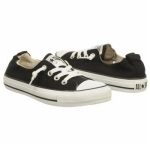
We’ll start from the bottom up, as shoes are a big part of what identifies the Natural-Relaxed style archetype. Sneaks, slip-ons, huaraches, espadrilles – all these say Natural. If it doesn’t require a lot of fussing with, is more about substance than style, comfort than statement, it’s likely a Natural-Relaxed shoe.
Many natural fibers, of course, read as Natural-Relaxed – with the possible exception of silk, unless it’s sueded silk. Suede, wool, cashmere, linen, hemp, bamboo (yes, a great new fabric) generally are less structured and more forgiving. Whereas leather says a bit of Drama, suede is usually Natural-Relaxed (and sometimes Romantic, as we 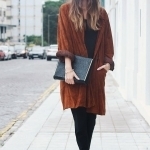 can see both elements in this gorgeous coat…the drapiness is a bit Romantic, but it’s a pretty yummy suede and yumminess often says “Natural.”)
can see both elements in this gorgeous coat…the drapiness is a bit Romantic, but it’s a pretty yummy suede and yumminess often says “Natural.”)
One of the hallmarks of this style archetype is the idea of un-constructed tailoring. That means you won’t find a lot of stiffness in a Natural’s garments. No shoulder pads, no stiff lapels, crisp pocket welts, or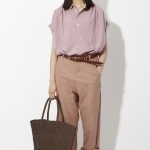 clean creases. The easy hang of the blouse and linen trousers on our girl to the right, plus the raffia woven tote, all say Natural. The only hint of something slightly Classic is the belt, but even it is styled almost as an afterthought.
clean creases. The easy hang of the blouse and linen trousers on our girl to the right, plus the raffia woven tote, all say Natural. The only hint of something slightly Classic is the belt, but even it is styled almost as an afterthought.
And let’s not forget denim. Denim is the go-to fiber for almost every Natural-Relaxed type. Yes, it’s so 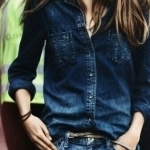 ubiquitous that it’s become a classic and therefore everyone is wearing it. But there is denim…and there is DENIM. Only someone with a lot of Natural-Relaxed could get away with this much of it at a time. But a Natural’s denim won’t be in a super skinny, bedazzled or embellished pair of jeans.
ubiquitous that it’s become a classic and therefore everyone is wearing it. But there is denim…and there is DENIM. Only someone with a lot of Natural-Relaxed could get away with this much of it at a time. But a Natural’s denim won’t be in a super skinny, bedazzled or embellished pair of jeans.
And finally, just so you don’t despair of ever looking very pulled-together if you have a lot of the Natural-Relaxed archetype, here’s a lovely example of how it works in a less casual 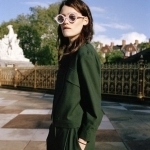 environment. This green wool pantsuit (I think it’s a pantsuit -maybe just a jacket and pants) is a Natural’s version of classic. The styling may be a bit more formal, but everything about it says easy-going. One more boon here: pockets! Naturals love pockets on anything.
environment. This green wool pantsuit (I think it’s a pantsuit -maybe just a jacket and pants) is a Natural’s version of classic. The styling may be a bit more formal, but everything about it says easy-going. One more boon here: pockets! Naturals love pockets on anything.
So, how much of the Natural style type do you have? As for myself – I can definitely relate. I’ve got 30% of this style essence. Anything over 15% is considered a pretty strong element of one’s personal style. In chapter 3 of Shopping for the Real You I offer a detailed questionnaire to help you figure that out. You can also get a Skype style consultation with my mentor, John Kitchener to find your style essences.
Post script: That illustration at the beginning? It was actually designed as a “Don’t” in the chapter in my book about Proportion, Balance and Scale. Wouldn’t ya just know that those shapes and proportions would appear everywhere in fashion now! (Look a sites like COS and Ayr if you don’t believe me.)
sites like COS and Ayr if you don’t believe me.)
The post Style type #2: How Natural–Relaxed Are You? appeared first on Shopping for the Real You.
February 25, 2015
What’s Your Style Type? #1 Dramatic-Theatrical
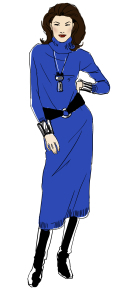
Illustration Sue Tait Porcaro
Last year I posted a series about the four seasonal color archetypes. Now we’re going to dive into the fascinating topic of the seven individual style archetypes. As described in Shopping for the Real You it’s a rare person whose features, coloring, expression, etc. reflect one single style facet. So this analysis is primarily for the purpose of training your eye to see differences and patterns unique to each style. Once you understand the basics of these types (or if you have been fortunate to have had a personal style consultation with John Kitchener) your own facets gradually come more and more into focus. But always keep in mind my motto:
Train your eye; trust your gut; don’t obsess.
Let’s start with the most yang of the archetypes: Dramatic-Theatrical.
These people are not wallflowers. But they’re also not overly in-your-face. There’s a quiet intensity about Dramatics. They know they command the room so they don’t need to go through a lot of histrionics to get attention. The pure archetypes are generally quite tall, have one or more exaggerated features, and very often have coloring in the winter Bold range. John calls the winter color types “Striking/Contrast,” and that also pretty much sets the tone for this style archetype as well. They have clear ideas and opinions. You’ll see a lot of them in entertainment, as business leaders (well, maybe not in Silicon Valley) or on fashion runways.
Let’s look at a couple of examples from my Dramatic/Theatrical Pinterest page.
This is model Catherine Servel wearing a Dries van Noten coat. The scale of the stripes and the contrast of the colors plus her strong bone structure all say “drama.” Even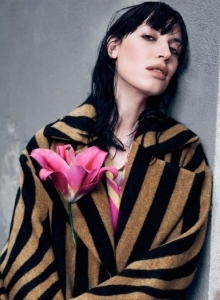 the petals of the pink lily, which because of its color would ordinarily read “spring,” are exaggerated in shape. Also, her coloring, with that very pale skin and very dark hair allows for greater contrast in what she wears. Yes there’s something very romantic about her expression, her mouth and the color of the flower. But pay attention to the scale of the pattern and the over-sized shape of the coat. That’s pure Drama.
the petals of the pink lily, which because of its color would ordinarily read “spring,” are exaggerated in shape. Also, her coloring, with that very pale skin and very dark hair allows for greater contrast in what she wears. Yes there’s something very romantic about her expression, her mouth and the color of the flower. But pay attention to the scale of the pattern and the over-sized shape of the coat. That’s pure Drama.
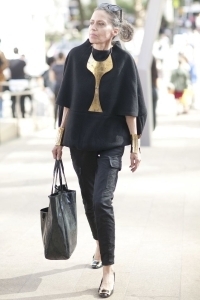 This image (to the left) is particularly interesting. If you look at her hair texture and eyes there is something vulnerable and soft there – almost Angelic. But the breast plate/necklace and wrist cuffs read almost “superhero.” And notice the intensity of her expression. The scale of the neck piece and cuffs, plus the size of her tote require a person who has a lot of Drama. There aren’t many people who could pull off those accessories. She certainly does. With aplomb!
This image (to the left) is particularly interesting. If you look at her hair texture and eyes there is something vulnerable and soft there – almost Angelic. But the breast plate/necklace and wrist cuffs read almost “superhero.” And notice the intensity of her expression. The scale of the neck piece and cuffs, plus the size of her tote require a person who has a lot of Drama. There aren’t many people who could pull off those accessories. She certainly does. With aplomb!
There’s not a lot of ambiguity in these Dramatic type women. They catch your attention and it’s hard to look away from them. But there’s nothing forced about what they are expressing. They are simply being who they are – fundamentally, intrinsically, Dramatic.
Here’s an interesting one that demonstrates how to look for Drama in someone with a 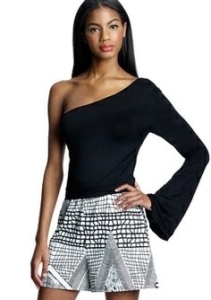 combination of styles. The exaggerated silhouette of the one sleeved top coupled with her pose and expression all read as Drama. However, this young woman has a lot of the Romantic style type as witnessed by her round or heart-shaped face shape (pure Dramatics often have a very oval-shaped face) and mouth. Still, her eyes have more intensity than that typically found in a pure Romantic type. Also, even though there is some warmth to her coloring she can clearly wear high contrast which, as mentioned earlier, is very often associated with Dramatics.
combination of styles. The exaggerated silhouette of the one sleeved top coupled with her pose and expression all read as Drama. However, this young woman has a lot of the Romantic style type as witnessed by her round or heart-shaped face shape (pure Dramatics often have a very oval-shaped face) and mouth. Still, her eyes have more intensity than that typically found in a pure Romantic type. Also, even though there is some warmth to her coloring she can clearly wear high contrast which, as mentioned earlier, is very often associated with Dramatics.
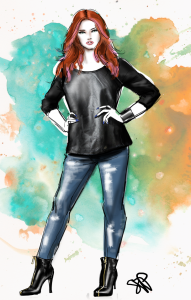
Illustration Sue Tait Porcaro
Finally, let’s look at something a little bit atypical. Our redhead here is not a Bold or Winter type in coloring, but she still checks many of the boxes of the Dramatic style type. Like our previous model, she also has got some Romantic going on, but what she’s communicating is less “come hither” than “You talking to me?” There’s a kind of haughtiness in that expression. (Interesting that both these girls have hands on their hips.)
Although the cut of her “T-shirt” is fairly classic, what is it made of? Black leather! Black leather immediately says drama. And check out the high heeled booties: Again, black leather, with obvious hardware (large-scale zippers.) When you think of drama, think of what the word “yang” signifies: dynamism, substance, clarity. These are common elements of Drama in a person’s style facets.
So – based on these descriptions, how much drama do you think you have in your personal style? (FYI: in case you can’t tell from my picture – I’ve got zero!)

The post What’s Your Style Type? #1 Dramatic-Theatrical appeared first on Shopping for the Real You.
January 22, 2015
What to wear at any age – 30, 40, 50, 60…Really??
 You’ve probably seen those spreads in fashion magazines advising you how to wear this season’s new colors and fashions if you are 30, 40, 50, 60 and older. Uh huh…riiight.
You’ve probably seen those spreads in fashion magazines advising you how to wear this season’s new colors and fashions if you are 30, 40, 50, 60 and older. Uh huh…riiight.
This is one of my pet peeves: you just can’t lump everyone in a generational pool.
It’s not that there isn’t value in dressing appropriately for one’s age. I totally get that. But to think that certain color families and silhouettes speak more to certain age demographics is to completely ignore differences in coloring and personal style.
The scale, cut, and color of an article of clothing should always be what determines if something works for you or not. In the photo here you’ll see that jeans work for women of almost any age-(no comment on these specific jeans. however.)
So, in a nutshell, don’t let anyone tell you what you should or shouldn’t wear. But if you need some help figuring out what’s flattering for your body now, that’s another subject. In that case, here are a few common sense guidelines:
1) The younger you are the more skin you can bare; more mature women benefit by creating a little mystery and covering up whatever “keeps them guessing.”
2) If your legs look great well into your 50s, 60s or even 70s, why not show them off? Just don’t go too short with your skirts. If you’re not thrilled with the texture of your skin, the shape of your knees, or the predominance of your veins wear colored stockings or tights.
3) Ditto for arms – show off your toned arms, but if you’re not crazy about how they look, wear longer sleeves.
4) Shoes: everyone’s source of joy – or suffering. The heel height of your shoes should be determined ONLY by the following: are they comfortable, can you walk safely in them without toppling, and do they enhance your overall look? That pretty much covers all the bases from sneakers to stilettos.
So, when you see something in a magazine that calls out to you, run it past these guidelines, and then ask yourself if it will go with anything else that’s already in your closet. If it does, that’s an indication that it suits your coloring and personal style. If it doesn’t, forget it. You’re likely just being lured by marketing hype.
BTW – Everyone who signs up to receive these regular blog posts will receive five very useful tips from my book, Shopping for the Real You. (I don’t share my email list and promise to NEVER flood your inbox with daily reminders. I find it extremely annoying myself and won’t do that to my readers.)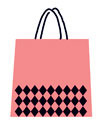
The post What to wear at any age – 30, 40, 50, 60…Really?? appeared first on Shopping for the Real You.
January 6, 2015
Why We Shop… And Why It’s Good for Us
When the Dalai Lama was first installed as the spiritual leader of Tibet he admitted that one of his very first thoughts was “I wonder how I’m going to look in those robes?” I loved his candor and honesty. It’s a rare person who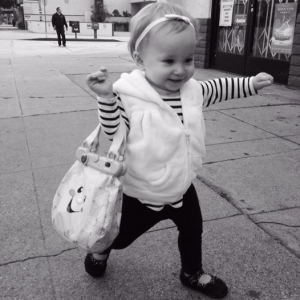 doesn’t care how they look.
doesn’t care how they look.
If we believe that the entire state of the world is summarized in the tragedies and imponderable events on the nightly news, we might conclude that any activity having to do with commerce –particularly something like shopping for clothes – is meaningless and superficial.
I emphatically disagree!
How we dress, how we present ourselves when we step out the door, or even when we just stay hunkered down in our own abode, says a lot about how we feel about ourselves. It’s one of the most direct reflections of how much we are willing to engage in life.
Life is about growth, evolution, and progress. And the fashion world, for all its quirks and commercial eccentricities, is – at its best – a mirror of that evolution. Buying something new and maybe a little bit – dare we say it “fashionable” – keeps us in the path of life. When we find a new article of clothing that brings us joy or that makes us feel authentic and beautiful we are making a statement: “I’m alive, I deserve to be seen, and look what beauty I can contribute to the world.”
That said, I’m not advocating throwing out last year’s wardrobe. I’m simply giving permission to anyone who needs it to fully enjoy one of the more delightful pleasures in life. My goal for you the com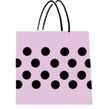 ing year is that every clothing purchase you make is purposeful and makes you feel attractive and alive every time you wear it – whether it’s something off the rack at Neiman Marcus or a real treasure found at the Goodwill.
ing year is that every clothing purchase you make is purposeful and makes you feel attractive and alive every time you wear it – whether it’s something off the rack at Neiman Marcus or a real treasure found at the Goodwill.
Here’s to a joyful and fashionable 2015!
The post Why We Shop… And Why It’s Good for Us appeared first on Shopping for the Real You.
November 26, 2014
Shopping for Quality… At a Bargain
 In Shopping for the Real You I strongly advocate buying the best quality clothing you can afford. That’s because, generally, when you pay a little extra you’re going to get a better quality fabric, cut, or construction. But everybody – and I mean everybody – loves a bargain. If you know how to play it right you can usually get that higher quality item for a better price. Here are some keys to buying quality at a bargain.
In Shopping for the Real You I strongly advocate buying the best quality clothing you can afford. That’s because, generally, when you pay a little extra you’re going to get a better quality fabric, cut, or construction. But everybody – and I mean everybody – loves a bargain. If you know how to play it right you can usually get that higher quality item for a better price. Here are some keys to buying quality at a bargain.
1) First of all, if you shop frequently at a particular retailer and for a specific designer, get to know a salesperson in that department. She – or he – will alert you when your favorite designer items are coming on sale.
2) Some high end department stores (Saks, Neiman’s, Barney’s and Nordstrom… Bergdorf’s just won’t go there) each have their own discount sites: Barney’s Warehouse; Hautelook: (Online version of Nordstrom’s Rack); Last call: (Neiman’s online outlet); and Saksoff5th.
2) If you order from an online retail store you are pretty much guaranteed to be their new best friend. Your inbox will be flooded daily with updates on their latest sales. And they all have a “sale” page on their website. Also, There are online outlets for specific labels, e.g., Coach, Tommy Hilfiger, J. Crew. When you do a search on the name of your favorite retailer just add “outlet.” You’ll likely get a listing of their bricks and mortar outlet stores but if they have an online one, that version will show up too.
3) If you know exactly the designer and item that you want The Find scans more than 500,000 retailers, finds it, and lists all available coupon codes applicable. Once you do find it, an app called Shoptagr keeps tabs of that item and lets you know when it goes on sale.
4) Finally, there are several outlet “collection” websites that partner with design houses or retailers who want to unload overstock merchandise. But heads up: just as with bricks and mortar outlets, many of these items are not regular merchandise on sale but cheaper, schlock-y stuff manufactured just for these websites. But if you have the time – and the patience – to sort through the weeds you can find some real gems.
Here’s my somewhat long “short list” of several of these sites.
6pm.com: Zappo’s answer to department store outlets. Some good deals here, including an epic amount of jeans.
Bluefly: carries items from over 40 higher-end (and some mid-level) designers but unless you want a pre-owned handbag, you won’t find any Chanel…sigh (anyone out there know of a Chanel outlet?)
Century 21: (Not the realtor…) From pricier (but limited number) designer things to super cheap.
Gilt: The granddaddy of the genre: from very high end to affordable.
Ideel: Limited time sales of designer (and mid-level overstock) items.
Lyst: Mostly designer items at full price but has a sale page that re-directs you to other sites for high-end sale items.
My Habit: Amazon’s discount warehouse limited time sales. Some things they’re practically giving away, (and you can tell why) and some designer.
Ruelala: High quality name brands and designer items, limited amounts.
The Outnet: (My personal downfall) heavily discounted designer and in-house brand. This is net-a-porter’s discount wing.
Yoox: As many full-price as discounted (40-70%) designer items. I love that they show available sizes right on the thumbnail images.
And since we’re talking about bargains, I’m offering a 20% discount on my book, Shopping for the Real You, from now through December 10 when you order from my website. Enter coupon code: Bargain at checkout. (Because we ship book rate we have to receive your order by the 10th.) Such a deal! Also, be sure to subscribe to my blog and you’ll be notified when my new ebook, “Good Jeans” is available!
The post Shopping for Quality… At a Bargain appeared first on Shopping for the Real You.
November 7, 2014
Color Versus Style: Part 2
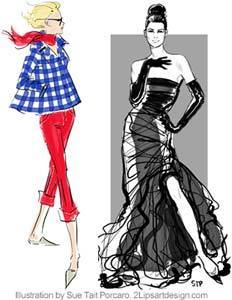 In my last post I described how designers create similar colors and style types of clothing (in terms of fabric weight and color palette) for each season year after year.
In my last post I described how designers create similar colors and style types of clothing (in terms of fabric weight and color palette) for each season year after year.
So, paying attention to your specific coloring and style type(s) becomes very important when your own seasonal color palette and style type is out of synch with the current season’s predominant colors and style.
Now we’re going to talk about how catalogs, websites, and magazines can add to the challenge – and your confusion.
From economic and practical necessity, fashion editors – particularly those who edit catalogs –choose one or two models to show an entire season’s line. For example, they will dress a bold and striking colored brunette in everything from contrasting color block to soft and subtle pastels. So, if you happen to be primarily a bold “winter” color type you have to be discerning and determining which pieces will work for you.
in everything from contrasting color block to soft and subtle pastels. So, if you happen to be primarily a bold “winter” color type you have to be discerning and determining which pieces will work for you.
This is also common on the runways during fashion week. Designers will work with a particular color palette whether or not it suits the coloring of all the models.
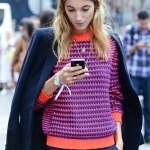 Also, check out any number of arrivestes attending fashion week and you’ll see some of the most egregious examples of this. Yes, they frequently put together the pieces together rather artistically, but would you actually wear it?
Also, check out any number of arrivestes attending fashion week and you’ll see some of the most egregious examples of this. Yes, they frequently put together the pieces together rather artistically, but would you actually wear it?
Another visual disconnect involves movie stars and models who are featured in magazines. (There are some magazines that do this better than others, however – and Bazaar comes to mind.) You’ll see a fashion blogger, model, or movie/TV star wearing a creative and hip combination of pieces that have nothing to do with her intrinsic coloring.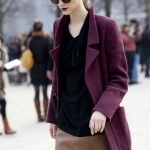
This is so much the case that when you see something really pleasing and harmonious it jumps off the page and makes you feel calm in your heart rather than confused and edgy.
So, can you wear one of those edgier, artistic outfits that stand on their own and don’t necessarily complement your own coloring? Of course! Absolutely. But just what are you projecting? What are you communicating? Is that really what you want to say? Are you happy 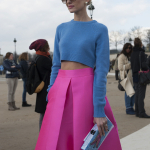 wearing costume art? And does it express the real you?
wearing costume art? And does it express the real you?
Always ask yourself those questions before plunking down your credit card. Here’s to the real you!

The post Color Versus Style: Part 2 appeared first on Shopping for the Real You.
October 16, 2014
Color vs. Style: Part 1
 Being a smart shopper means knowing the difference between color and style. Sure, they sound like different things. But that distinction often gets muddied. In this post we’re going to explore why this is by looking at the conventional relationships between certain seasonal color palettes and certain style archetypes.
Being a smart shopper means knowing the difference between color and style. Sure, they sound like different things. But that distinction often gets muddied. In this post we’re going to explore why this is by looking at the conventional relationships between certain seasonal color palettes and certain style archetypes.
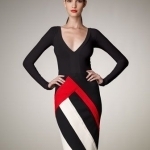
Winter: Let’s start with winter Bold colors. You’ll often find these in Dramatic/Theatrical cuts and patterns. And the reality is that a lot of Dramatic style types often can, in fact, wear bold colors. Since the nature of winter is that of intensity and drama the patterns and designs expressed in the dead of winter frequently reflect that drama: color blocking, extreme shapes, exaggerated patterns.
Spring: As winter transitions to spring, the Bright spring palette is found in the cuts, styles and patterns typical of Youthful/Playful style. Even the word “spring” suggests a kind of innocence and awakening. Those qualities play well with typical spring 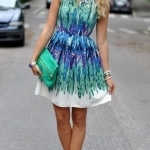 patterns and styles: smaller florals, checkered fabrics, bright, playful designs, and more feminine or round shapes rather than the extreme lines and cuts that typically are seen in the striking colors of winter.
patterns and styles: smaller florals, checkered fabrics, bright, playful designs, and more feminine or round shapes rather than the extreme lines and cuts that typically are seen in the striking colors of winter.
Summer: Angelic/Ethereal types might notice that a lot of things in their closet seem to fall into the Soft/Subtle Summer color palette. There’s an automatic relationship we form between those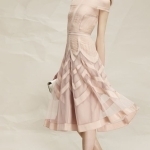 gentle, often grayed colors and the breezy, gauzy fabrics that we can only wear in the summer. These are the colors we also associate with the sort of liquid, diaphanous quality we see in people with a lot of the Angelic style type. Also, since many weddings take place in the summer, we make a connection between lighter colors and wedding attire – both for the guests as well as the bride. (And, by the way, you’ll see a lot of mother-of-the-bride dresses in this grayed palette.)
gentle, often grayed colors and the breezy, gauzy fabrics that we can only wear in the summer. These are the colors we also associate with the sort of liquid, diaphanous quality we see in people with a lot of the Angelic style type. Also, since many weddings take place in the summer, we make a connection between lighter colors and wedding attire – both for the guests as well as the bride. (And, by the way, you’ll see a lot of mother-of-the-bride dresses in this grayed palette.)
Fall: And then when autumn rolls around we want to start wearing more layers. Except in a few anomalous years, you’re most likely to find those less popular autumn colored garments primarily in the autumn – cozy sweaters, pants and jackets. You’ll also start seeing more of the Natural/Relaxed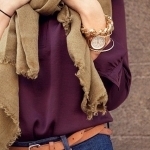 textures such as ribbed and cabled knits, corduroy pants and tops, suede in various garments and the heavier weaves of cashmere. (Those feather weight cashmere cardigans are a godsend in air conditioned offices, but you need heavier weights in the winter.) There’s an obvious link between autumn colors and heavier fabrics and textures.
textures such as ribbed and cabled knits, corduroy pants and tops, suede in various garments and the heavier weaves of cashmere. (Those feather weight cashmere cardigans are a godsend in air conditioned offices, but you need heavier weights in the winter.) There’s an obvious link between autumn colors and heavier fabrics and textures.
So what you do if – like most of us – your color palette and style types cross multiple seasons and archetypes? If, for example, you’re primarily a Natural/Relaxed style type but your coloring is very much in the spring Bright palette, rather than autumn? Or if you’re a Youthful/Playful style type but your coloring is clearly that of the winter palette? Or if you have a lot of the three other style types not mentioned here because they cross multiple seasons: Classic, Exuberant, or Romantic?
My advice is this: look for your ideal colors first. Every season you will find something that will work. Maybe it’s just an accessory that you wear with your neutrals. Maybe it’s a sweater or a blouse. Even if you have a only small amount of the current seasonal colors in your personal palette, wear that small amount. Find those one or two great things that highlight your coloring and then wear them to death with your basics for that season.
My book, Shopping for the Real You, offers fundamental guidelines to determine the colors and styles that can work best for you. (A heads up: my mentor John Kitchener is currently offering a discount for individual color and style analysis.)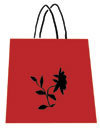
In the next post I’ll talk about the second element in color versus style confusion: Models, celebrities and magazines.
The post Color vs. Style: Part 1 appeared first on Shopping for the Real You.
September 29, 2014
(She’s Got) Good Jeans
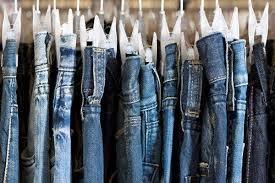 Mom jeans, skinny jeans, boyfriend jeans: everybody wears them (well, almost everyone –there likely are few people – somewhere – who wouldn’t be caught dead in them.)
Mom jeans, skinny jeans, boyfriend jeans: everybody wears them (well, almost everyone –there likely are few people – somewhere – who wouldn’t be caught dead in them.)
Fortunately for us jeans lovers, this season jeans are hot! In fact, denim is appearing in every form including jackets, dresses and accessories. That coat and accessories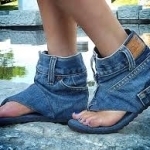 thing is a trend I don’t quite get. Unless you live in warmer climates a denim shirt, dress, or especially a coat is not going to keep you warm in a polar vortex. But I digress…
thing is a trend I don’t quite get. Unless you live in warmer climates a denim shirt, dress, or especially a coat is not going to keep you warm in a polar vortex. But I digress…
Let’s go over a few basics of choosing the right jeans:
Wearability: First and foremost – are they comfortable?
Fit: When you squat or bend over do they cover your backside?
 Shape: Do they flatter your assets and de-emphasize something you’d rather not highlight?
Shape: Do they flatter your assets and de-emphasize something you’d rather not highlight?
You’ll also want to consider how casual or pulled together you want to look. That will determine the color or rinse you choose. Darker rinses and colors automatically read a little more conservative. You’ll also want to check the rise (distance from navel to crotch.) The lower the rise, the more casual the overall look.
Next, pay attention to what kind of shoes will complement the length and shape of the leg. Sneakers, flats and brogues look best with boyfriend jeans and rolled-up cuffs. Heels work better with skinny or wide leg jeans.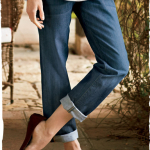
And of course, you want to be mindful of the age appropriateness of the cut and style. Ripped jeans can be playful or tongue-in-cheek on a younger body but might read a tad desperate on someone older.
I’m currently writing a short e-book all about shopping for jeans that will incude price points and where to find your perfect pair! If you sign up for my blog (click the “subscribe today” button on the sidebar) I’ll let you know when it’s available.
 I’d also love to hear your personal stories about your favorite pair, how long you’ve had them, and why you love them. Write me at: [email protected]
I’d also love to hear your personal stories about your favorite pair, how long you’ve had them, and why you love them. Write me at: [email protected]
The post (She’s Got) Good Jeans appeared first on Shopping for the Real You.
September 4, 2014
Vintage…or Out of Date?
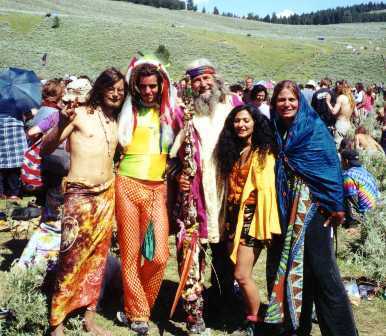 Many years ago a designer friend explained to me that when a “retro” style is revisited something significant has been changed from the original version. This doesn’t always mean that a high–quality and classically elegant vintage piece goes out of style. It simply means that this year’s boho dress is not the same as the 1970s version.
Many years ago a designer friend explained to me that when a “retro” style is revisited something significant has been changed from the original version. This doesn’t always mean that a high–quality and classically elegant vintage piece goes out of style. It simply means that this year’s boho dress is not the same as the 1970s version.
That’s because fashion in every era reflects the times in which it’s created. For example, let’s look at these two 1970s-era fringed jackets. The first one looks like something right out of Daniel Boone’s closet. 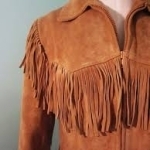 You saw a lot of them on rock ‘n roll icons of the time like Neil Young and Roger Daltry. The second one implies Native American dress. (Well, Neil has some claim to this in that he is in fact Native American.)
You saw a lot of them on rock ‘n roll icons of the time like Neil Young and Roger Daltry. The second one implies Native American dress. (Well, Neil has some claim to this in that he is in fact Native American.) 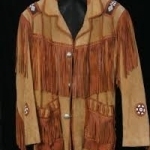 When you think about the 1970s it was a period where a generation wanted to “get back to the land” like pioneers and as did many 1970s commune dwellers. It was also a time of awakening about the multicultural identity of the US, which explains the references in this garment to that of Native American garb.
When you think about the 1970s it was a period where a generation wanted to “get back to the land” like pioneers and as did many 1970s commune dwellers. It was also a time of awakening about the multicultural identity of the US, which explains the references in this garment to that of Native American garb.
 Now let’s look at the revision of the fringed jacket, popular today. The first one has an almost minimalist vibe to it. It says “I’m hip but not a hippie.” The line and drape are less structured, more refined, and more classic in their expression of naturalism. (This particular piece actually would work well on somebody who has a lot of both the Classical and Natural style type.)
Now let’s look at the revision of the fringed jacket, popular today. The first one has an almost minimalist vibe to it. It says “I’m hip but not a hippie.” The line and drape are less structured, more refined, and more classic in their expression of naturalism. (This particular piece actually would work well on somebody who has a lot of both the Classical and Natural style type.)
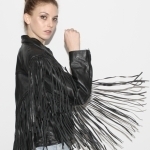 The second one is more about art than about political statement, although in its own way it is making a pretty strong statement. It implies a bold, fearless, and feminist wearer. Back in the 70s you’d typically only see this long a fringe on a man’s jacket. This girl is like the love child of those 70s parents. She’s doing it her own way—more edgy and plugged in, as is the nature of our current times. (This one works best on someone with winter’s Bold coloring and Dramatic/Theatrical style.)
The second one is more about art than about political statement, although in its own way it is making a pretty strong statement. It implies a bold, fearless, and feminist wearer. Back in the 70s you’d typically only see this long a fringe on a man’s jacket. This girl is like the love child of those 70s parents. She’s doing it her own way—more edgy and plugged in, as is the nature of our current times. (This one works best on someone with winter’s Bold coloring and Dramatic/Theatrical style.)
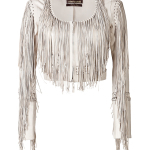 This last one, from Roberto Cavalli, is the high-end of contemporary hippie chic and crosses multiple style types. Because of the lower neckline a Romantic could wear it. The color and short waist works well for a Youthful, and the fringe says Natural. But because of its somewhat other-worldliness it also has an Angelic Quality to it too.
This last one, from Roberto Cavalli, is the high-end of contemporary hippie chic and crosses multiple style types. Because of the lower neckline a Romantic could wear it. The color and short waist works well for a Youthful, and the fringe says Natural. But because of its somewhat other-worldliness it also has an Angelic Quality to it too.
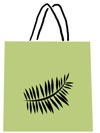 If you’ve had something sitting in the back of your closet for a couple of decades that now seems to be back in fashion, examine it closely before you dust it off and wear it out the door. Sometimes vintage really is outdated.
If you’ve had something sitting in the back of your closet for a couple of decades that now seems to be back in fashion, examine it closely before you dust it off and wear it out the door. Sometimes vintage really is outdated.
Learn more about personal style in Shopping for the Real You, available on Amazon: Click Here.
The post Vintage…or Out of Date? appeared first on Shopping for the Real You.



